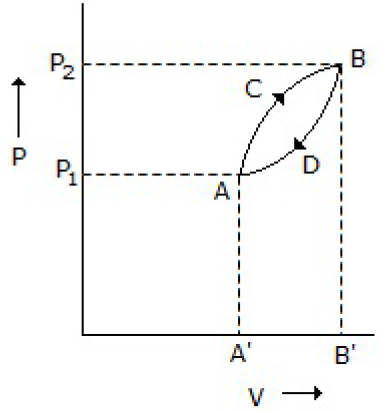Helmholtz free energy (A) is defined as
A = H - TS
A = E - TS
A = H + TS
None of these
Correct Answer :
B. A = E - TS
Related Questions
__________ decreases during adiabatic throttling of a perfect gas.
Entropy
Temperature
Enthalpy
Pressure
A large iceberg melts at the base, but not at the top, because of the reason that
Ice at the base contains impurities which lowers its melting point
Due to the high pressure at the base, its melting point reduces
The iceberg remains in a warmer condition at the base
All (A), (B) and (C)
For a given substance at a specified temperature, activity is __________ to fugacity.
Directly proportional
Inversely proportional
Equal
None of these
Tea kept in a thermos flask is vigorously shaken. If the tea is considered as a system, then its temperature will
Increase
Decrease
Remain unchanged
First fall and then rise
For a multi-component system, the term chemical potential is equivalent to the
Molal concentration difference
Molar free energy
Partial molar free energy
Molar free energy change
The equation Tds = dE - PdV applies to
Single phase fluid of varying composition
Single phase fluid of constant composition
Open as well as closed systems
Both (B) and (C)
During Joule-Thomson expansion of gases
Enthalpy remains constant
Entropy remains constant
Temperature remains constant
None of these
A reasonably general expression for vapourliquid phase equilibrium at low to moderate pressure is φi yi P = Yi xifi° where, Φ is a vapor fugacity component, Yi is the liquid activity co-efficient and fi° is the fugacity of the pure component i. the Ki value (Yi = Ki xi) is therefore, in general a function of
Temperature only
Temperature and pressure only
Temperature, pressure and liquid composition xi only
Temperature, pressure, liquid composition xi and vapour composition yi
The expression for entropy change, ΔS = n Cp . ln (T2/T1), is valid for the __________ of a substance.
Simultaneous pressure & temperature change
Heating
Cooling
Both (B) and (C)
Van Laar equation deals with the activity coefficients in
Binary solutions
Ternary solutions
Azeotropic mixture only
None of these
The work done in an adiabatic change in a particular gas depends upon changes in the __________ only.
Temperature
Specific heat
Volume
Pressure
__________ does not change during phase transformation processes like sublimation, melting & vaporisation.
Entropy
Gibbs free energy
Internal energy
All (A), (B) & (C)
The temperature at the eutectic point of the system is the __________ temperature that can be attained in the system.
Lowest
Highest
Average
None of these
While dissolving a gas into a liquid at a constant temperature, the ratio of the concentration of the gas in the solution phase and in the gaseous phase is
Infinity
Unity
Constant
Negative
A thermodynamic system is taken from state A to B along ACB and is brought back to A along BDA as shown below in the P-V diagram. The net work done during the complete cycle is given by the area covered by

P1ACBP2P1
ACBB1A1A
ACBDA
ADBB1A1A
For a real gas, the chemical potential is given by
RT d ln P
RT d ln f
R d ln f
None of these
The reaction A (l) → R(g) is allowed to reach equilibrium conditions in an autoclave. At equilibrium, there are two phases, one a pure liquid phase of A and the other a vapor phase of A, R and S. Initially A alone is present. The numbers of degrees of freedom are:
1
2
3
0
Enthalpy changes over a constant pressure path are always zero for __________ gas.
Any
A perfect
An easily liquefiable
A real
If the molar heat capacities (Cp or Cv) of the reactants and products of a chemical reaction are identical, then, with the increase in temperature, the heat of reaction will
Increase
Decrease
Remain unaltered
Increase or decrease; depends on the particular reaction
High __________ is an undesirable property for a good refrigerant.
Specific heat
Latent heat of vaporisation
Viscosity
Specific vapor volume
At the critical point of a substance
The surface tension vanishes
Liquid and vapour have the same density
There is no distinction between liquid and vapour phases
All (A), (B) and (C)
Claude gas liquefaction process employs cooling
At constant pressure
By throttling
By expansion in an engine
None of these
Which of the following is not an intensive property?
Volume
Density
Temperature
Pressure
The equation DU = Tds - PdV is applicable to infinitesimal changes occuring in
An open system of constant composition
A closed system of constant composition
An open system with changes in composition
A closed system with changes in composition
The efficiency of an Otto engine compared to that of a diesel engine, for the same compression ratio will be
More
Less
Same
Data insufficient to predict
Measurement of thermodynamic property of temperature is facilitated by __________ law of thermodynamics.
1st
Zeroth
3rd
None of these
Throttling process is a/an __________ process.
Reversible and isothermal
Irreversible and constant enthalpy
Reversible and constant entropy
Reversible and constant enthalpy
Number of components (C), phase (P) and degrees of freedom (F) are related by Gibbs phase rule as
P + F - C = 2
C = P - F + 2
F = C - P - 2
P = F - C - 2
What is the value of maximum COP in case of absorption refrigeration, if refrigeration provided is at temperature, TR (where, T1 and T2 are source & surrounding temperatures respectively.)?
TR/(T2 - TR) × (T1 - T2)/T1
TR/(T2 - TR) × T1/(T1 - T2)
TR/(T1 - TR) × (T1 - T2)/T1
None of these
Dry ice is
Moisture free ice
Solid helium
Solid carbon dioxide
None of these
